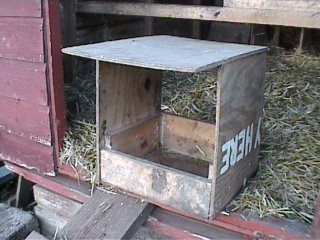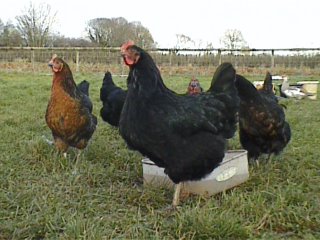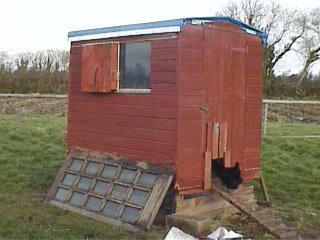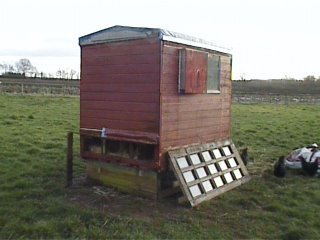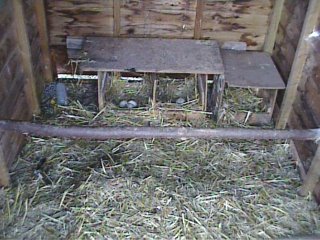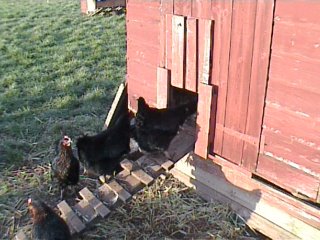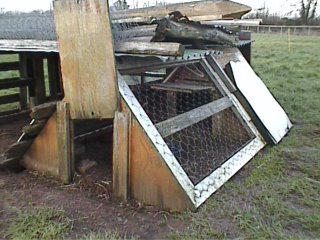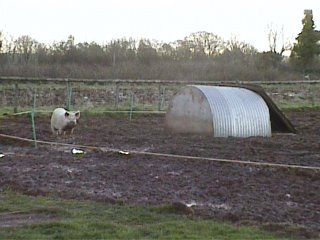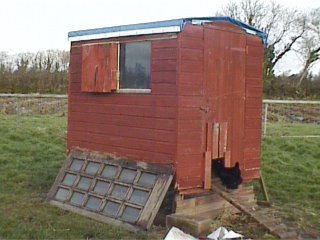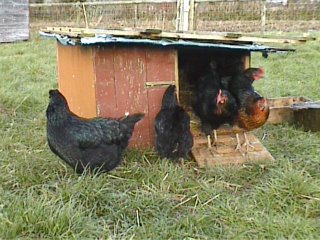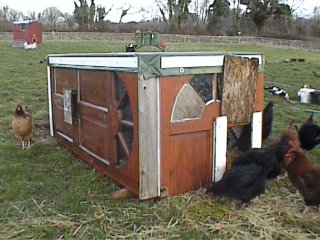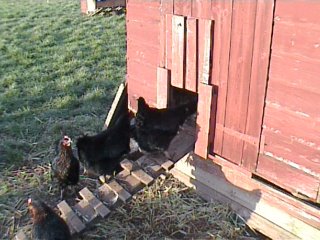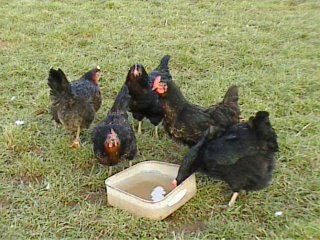Keeping Chickens at Home - Some FAQ's
Q. "What does 'broody' mean?"
A. Going "broody" just refers to the instinct a hen has to stop laying eggs every day and to start sitting on the ones she's already laid, so that in 21 days they will hatch into chicks (provided a rooster has been mating with the hen). Some chickens "go broody" all the time. They are often bantam breeds, such as Silkies, or mixed breeds. Most purebreds, like Rhode Island Reds, were themselves not hatched by a mother hen. They were hatched in an egg incubator in a hatchery somewhere. You see, if you want a chicken that lays a lot of eggs for eating, you don't want one that still has the instinct to stop laying eggs and sit on her eggs all the time. You want one that has had all the broody instincts bred out of her so she'll lay for you year-round. So farmers over the years have raised up what are known as utility breeds; chickens that don't go broody and that lay almost all year 'round.
Q. "My chicks are growing fast. How can I tell which ones are hens and which are roosters?"
A. If you bought "sexed" chickens, then most likely all your chickens are females. If you bought "straight run" chicks, then 50% will be males. Professional chicken sexors are employed by hatcheries and sexing chickens is difficult. When you see some of your chicks displaying "dominance behaviors" or other fighting type behavior, that won't tell you anything. All my hens, when they were chicks, would fight, spar, act dominant to the others. The best way is to wait until it is no longer a chick and almost full grown. You will start to see pointed sickle and saddle feathers on a male. Sickle feathers are the two long tail feathers, and saddle feathers are the feathers that grow on a rooster's back right on top of the rump. They will come to a point versus being rounded. Wait until you hear a crow before you get rid of a suspected rooster if you are a novice; that's what I still do.
Q. "If my Rhode Island Red hen won't brood, what will make her set? Do they need a special laying feed to make them go broody?"
A. If a hen doesn't have the instinct to sit on her eggs, there's nothing you can do. She doesn't have the mothering instinct. Special foods won't help, nor will keeping her confined with her eggs or bringing in a rooster. You might be thinking of "layer pellets," which is simply food fed to hens that have started to lay eggs and hence need extra calcium and other nutrients to make strong shells. So leaving the eggs in the nest in hopes she'll sit on them is kind of wasting good eating eggs.
Q. "How often will a grown hen lay eggs? How many a day? What's the physiological reason that a chicken lays an egg?"
A. I do get a lot of emails asking me about the basic biology of chickens such as this. A "production" breed, or chickens that have been bred over the decades to really crank out the eggs might lay you an egg every 24-36 hours, and keep that up almost year 'round. That would be a good production breed. Secondly, hens don't need a rooster around at all to lay their maximum number of eggs. One article which answers some basic chicken biology questions is here. In addition, here is a picture that shows the internal sex organs of most birds, including chickens. You can see that the external genitalia are the same in males and females. This external part is called the cloacae. ("klo-AY-kuh.") The cloacae is the common chamber into which the intestinal, urinary, and generative canals discharge in birds, reptiles, amphibians, and many fishes. That is to say, chickens poop, pee, lay eggs, and mate all via the same hole.
Q. "We'll probably get a couple of chickens now, and then maybe another later. Is that okay?"
A. That's the one thing that's hard to do with chickens: Introduce a new one into a pen of other chickens. The new one gets picked on. There are tricks you can do to get around actual bloodshed, however. You can introduce even numbers of birds, like put five new chickens in with five original chickens. Or you can toss up the ages and ratios: Put in a dozen youngsters in with just three adults, for example, and the adults will be overwhelmed. Another thing to do is to let the original chickens chase the new ones around, but provide hiding places for the new ones. Put a second feeder and a second waterer at the opposite end of the chicken pen or coop, so the new chickens can always access food and water. Also, I'll refer you to a good link: http://www.feathersite.com/Poultry/BRKRaisingChicks.html. Scroll down to the very last paragraph on that page for another technique on introducing new birds to a flock.
Q. "I am new at keeping chickens. I got them when they where born. Well, 2 of them have tried to attack me. I let them roam free and today one of them chased me into the house. I am afraid to go into my backyard. Have you ever heard of this?"
A. You really should keep your chickens in a pen of some kind. I would never let my chickens scare me out of my own yard. Take back the streets! I mean yard. Get those darned chickens in a pen where they belong. It will also keep them safer. If you let your chickens roam free, it is my personal opinion and experience that it's just a matter of time before they are harmed by predators.
Q. "What about parasites on or in my chickens? Do I have to deal with all that?"
A. You should dust your chickens every few months with an all-purpose pesticide dust, such as Sevin dust, or Hi-Yield Livestock & Garden dust. You can find canisters or bags of this stuff at any Agricultural Merchants. How I like to "dust" my chickens is to have a big shallow drawer or something, put sand or clean dirt in it, and mix a couple of cups of the pesticide dust in with it. Chickens love to take dust baths and will be dusting themselves in no time. Just leave the dusting bin in their run for a week or so. Also, chickens sometimes get worms. Just like puppies and kittens. Just for safety's sake, I like to worm my flock every 4-6 months. Buy a small bottle of chicken wormer from your local feed store, or you can order from the 'net, too. It simply involves adding some liquid medicine to their drinking water. Carefully follow the directions on the bottle.
Q. "What is coccidiosis?"
A. Coccidiosis (pronounced, “cock-sid-ee-O-sis”) is a common chicken disease. Poultry raised in crowded or unsanitary conditions (conditions that permit the build-up of a lot of oocysts in the environment) are at greatest risk of becoming infected. Wet areas around water fountains are a source of infection. Oocysts remain viable in litter for many months. In this way they can contaminate a farm from year to year. Oocysts are killed by freezing, extreme dryness and high temperatures. Several factors influence the severity of infection. Some of these are: An increase in the number of oocysts eaten causes an increase in the severity of the disease. Old birds are generally immune as a result of prior infection. Coccidiosis generally occurs more frequently during warmer weather (May to September). The most easily recognized clinical sign of severe coccidiosis is the presence of bloody droppings. Chickens droop, stop feeding, huddle together and by the fourth day blood begins to appear in the droppings. The greatest amount of blood appears by day five or six and by the eighth or ninth day the bird is either dead or on the way to recovery. Keep chicks, feed and water away from droppings as much as possible. Place water vessels on wire frames to eliminate a concentration of wet droppings, in which the chicks can walk to pick up or spread the disease. Keep litter dry and stirred frequently. Remove wet spots and replace with dry litter. Avoid overcrowding. If coccidiosis does break out, start treatment immediately. Amprolium (the stuff they put in medicated chick feed) or one of the sulpha-based drugs (such as Sulmet, which you can get at the feed store) is usually recommended. Follow directions on bottle to the letter.
Q. "Do your chicken eggs have little red spots in them?"
A. The blood spot that many people mistakenly take as a mark of a fertilized egg is actually blood from the hen. Not all eggs will have them. It happens when the hen is creating the egg in her body and a tiny blood vessel somewhere along the process ruptures and a tiny bit of chicken blood gets mixed into the formation process. People have long thought all sorts of erroneous things about chicken eggs: That fertilized ones are healthier, that free-range eggs are so much better for you, that organic ones have less cholesterol, that the blood spot is a mark of fertilization, etc.
Q. "When you say you can raise chickens in the city, you really mean in the suburbs, right? One can't raise chickens in a high rise apartment."
A. I raised a hen from a baby chick when I lived in an apartment once. It was a bantam breed and so only grew as large as a parrot, which people keep as pets all the time, and chickens can live outside. Except unlike a parrot, my species of bird would eat my kitchen scraps and give me eggs. The only thing I would do differently is raise two chicks at a minimum, as one chick gets very, very lonely. My apartment had a patio, and I don't see why a person couldn't modify a chicken tractor design to work for a patio. I personally think it's not too nice to keep a dog cooped up in an apartment, and people do that all the time. It might be challenging, but why couldn't city folks keep pets that are super practical and give them fresh eggs? Couldn't you collect the chicken droppings and put them in your planters on your patio where you are growing some tomatoes or flowers?
Q. "I prefer organic versus store-bought eggs and I have read all kind of hen house horror stories, so I would prefer to buy my family's eggs from chickens which don't spend their lives caged up in misery and pumped full of antibiotics and hormones."
A. It may not be supporting my own cause, but I am compelled to say: The only real difference you will be getting with backyard eggs is that they will be fresher, and a lot of people like that. They can have more brightly colored yolks. Otherwise they are essentially the same as store-bought eggs. I don't really like the idea of battery hens standing on wire the whole year or so they use them, but it might be a necessary evil. But even backyard hens have to live in a pen, because even city folks have raccoons, dogs and hawks to contend with. If I let my chickens roam the yard, they would be eaten in no time. But you're right; backyard hens definitely are not on wire floors and are able to scratch about happily in the straw or dirt, eat grass and food scraps, fly up to perches, lay in the sun, take dust baths, fight and/or preen each other, interact with each other, etc. I know egg industry hens are sometimes fed feed with antibiotics in it, but I've never heard of hens being given hormones.
Q. "Isn't it true that some free-range, organic, vegetarian hens lay eggs with 35% less cholesterol than regular eggs?"
A. It might indeed be true that the new "Omega 3" eggs developed at the University of Nevada can have up to 19% less cholesterol than regular eggs. However, it's the folks who are producing them who are reporting this; not an independent researcher. Foodwatch.com says Omega 3 eggs "do not have any less cholesterol but they have more omega 3 fatty acids." Foodwatch.com also says, "Despite these differences, all eggs have approximately the same amount of protein, total fat and cholesterol." These engineered eggs don't claim to be "organic" eggs. They are not free-range eggs. They just claim to have more Omega 3 fatty acids. What jumps out at me is that they are doing a lot of work (genetic selection, restricted feed, etc.) to make a relatively little change in eggs. The hens are still in cages and the hens are fed a fairly unnatural diet. So to me the eggs might be slightly healthier but are not particularly "natural." I would say it would be up to each individual consumer to decide which is their own personal lesser of two evils. Some folks who have high cholesterol might be grateful for any small change in an egg; others will still consider these to be battery hens that are caged and the resulting eggs are not free-range nor organically produced. Also, you might find some farms that make fairly amazing claims about their eggs. Buyer beware of such claims.
Q. No matter what I put my chicken's water in, they get dirt in it! Do you have any tricks for keeping their water supply unfouled?
A. They sell automatic watering systems, like the one seen here. But they require you to have them always hooked up to a water source, and most back yard poultry keepers don't get that complicated. I've used the plastic one gallon gravity feed ones (you have to refill them often), the 5 gallon plastic Dura Founts (two of them leaked/cracked on me), a plain plastic shoebox but placed very high on some boards and bricks, and other methods. The problem I have with the galvanized gravity feed ones is that although they can hold a lot of water, the actual reservoir holds only about a cup of water, and it gets dirty fast. So the chickens, although using a five gallon waterer, only have access to the trough of a cup or so of dirty warm water. That bothers me every time I look at it. Currently I'm using a five gallon bucket. You must keep the water topped off or the chickens won't be able to reach the water easily. With gravity feed waterers, you have to go into the poopy chicken pen to remove it, open it, refill it, and then lug 5 gallons of water back into the chicken pen. The bucket can be filled from outside the pen by sticking the garden hose through the wire; no top to unscrew. The bucket water level is right near the head-level of a standard breed bird. The water surface is high enough to keep most scratched-up dirt out of it. The dirt that does land in the water settles down to the bottom of the bucket. It is heavy so if the birds fly onto it, it won't tip over like a smaller bucket.
Q. "I gave my chickens a few worms. They loved those. Is it OK to do so?"
A. You will find that chickens are better than pigs for eating anything. Get a pretty ceramic bowl or container (I use a kid's sand pail), set it next to your kitchen sink, and throw all your food scraps into it. This will become your "chicken bucket." Then feed these scraps to the chickens. Empty the container daily so as not to breed germs. Dump the "chicken bucket" of food scraps into an old metal cake pan or the like that you leave in the chicken run. This way the scraps are kept off the ground and droppings. You can then easily dispose of any food that the chickens didn't eat that was left in the cake pan. You will find that chickens hardly refuse anything. It gives them food variety, too, and you will feel like you are not wasting food but recycling it. Think you can't put scrambled eggs or cooked chicken meat into the chicken bucket? Think again; those are among their favorites. I used to put even raw meat scraps in, but I've read that raw meat can transmit toxoplasmosis to animals, including chickens, and I wouldn't want myself or my kids to then come in contact with contaminated chicken manure. This is especially important for pregnant women. Some chicken fanciers are wholly against feeding human food to chickens. I just don't understand how some leftover Cheerios, which are enriched with vitamins, or bread or pasta made with enriched flour could possibly be bad for chickens. One time a mouse made a nest under one of my chickens' nest boxes, and when we moved the box, about 7 baby mice went scampering. My hens ate those baby mice so fast you wouldn't believe it. Chickens are the ultimate omnivores. Oh, and chickens love fresh grass clippings; be sure to put your garden clippings into the chicken pen. (Earthworms and other bugs, actually, can be carriers of microscopic parasitic chicken worms. My personal solution is to administer worming medicine via their water every 6 months versus never letting them eat worms or bugs.)
Q. "What kind of chicken food do I buy for my laying hens?"
A. Very simple: One should always provide free-choice commercial chicken food. Chicks should be fed "chick starter" clear up until you get your first egg, then switch to "layer pellets." That's it. Cracked corn or scratch grains are not sufficient. A chicken fed on only "chicken scratch" will be malnourished and fat. Q. "I was watching my chickens and they are pecking the feathers off of each other a lot. Could feeding them straight barley for a long time make them pick?" A. Absolutely. Chickens have been bred from the wild jungle fowl. In the wild, chickens eat beetles, worms, mice, carrion, bugs, flies, seeds, grasses, etc. They are omnivores, which means they eat meat and vegetable matter. They are omnivores in much the same way we humans are omnivores. So feeding them plain barley for a long time would be just as if you ate plain barley for a long time. You would start having strong cravings for protein, vitamins and minerals. You would become malnourished. Your chickens are picking each other and eating the feathers for protein and other trace minerals. "Scratch grains," such as barley kernels and cracked corn, are just extra treats for chickens. They should never be their only food. You should always provide commercially prepared chicken food for your captive chickens. Always. It should be "free choice," too, which means a supply should always be available and should never run out. So go out today and buy an all purpose chicken feed like Triple Duty or Chicken Mash or Crumbles. If your chickens are all older and are egg layers, you can get away with feeding Layer Pellets, as it is nutritionally complete for laying hens. Don't feed this to chicks or chickens who haven't started laying yet. They need Chick Starter until you see your first egg. A 25kg bag of chicken feed costs about £6. Also, put grass clippings in your pen as often as you can, as this helps cut down on pecking because it gives them something to do and is very healthy for them, as regular chicken feed, although nutritionally complete, has no green leafy living matter in it. Also provide grit (small gravel rocks you buy at the feed store) for your chickens.
Q. "What kind of bedding do you put in a hen house or chicken run?"
A. I can only speak from my own experiences, and I've tried a number of things: Sand, pea gravel, wood shavings, straw, etc. The main thing is that you want something that promotes drainage. If you have a muddy chicken run, then it is more conducive to disease. Some people throw straw in their chicken tractor or run, and then when it gets layered with poop and moisture, they throw on another layer of straw. This works, except for eventually, you have to remove the dirty straw, and in my experience the layers become very matted and almost woven/cemented together so that even with a shovel it is hard to get up. So I would suggest using one of those compressed bales of wood shavings for about £5. A bale for three hens lasts a long time and make things look "petting zoo" cute. It also doesn't mat together quite as bad as straw, you can layer fresh wood shavings on top of old, and it absorbs standing water or mud which can harbor an excess of pathogens. If you have very well-draining soil in your coop, or live where it is dry and warm a lot, you can also use no litter; just bare earth. Just rake out the dried poop occasionally.
Q. “Tell your site readers that chicken wire will not keep their chickens safe from dogs. We built a chicken Ark and still our dogs tore through the chicken wire and killed our two chickens.”
A. I’m so sorry to hear that. I will mention again about the danger of dogs around chickens. Determined dogs might indeed be able tear lightweight chicken wire off of its framework. I will advise builders to use lots and lots of extra long staples when attaching the chicken wire to their hen houses. I will also suggest that if using an ark to house chickens, the safest way is to keep the pen inside a fully fenced yard. That way, no stray or roaming dogs can come into your yard. If you have your own dogs sharing your yard with your chickens, I must simply say that there is no real way to fully trust dogs around chickens. If you have dogs, an ark may not be appropriate for you. You would have to use something very dog-proof to keep your dogs away from your chickens. Also, if a dog can’t tear through the chicken wire, it still might be able to tip over a very lightweight ark. So if you are going to leave your dogs unattended around your chicken ark, I would suggest building one or else put some kind of heavy object such as an old tire on top of it.
Q. "I've been told by several people that bantam hens have a very good disposition and are exceptionally easy to manage. In your experience are there any breeds that do better than others as pets?"
A. I've tried a lot of breeds, and ultimately, they are all chickens. In my experience, how "pet-like" a chicken is is directly related to how much it was handled while it was growing up. It will be unafraid of humans if humans handled it a lot and hand-fed it, etc. Some chicken fanciers will tell you that some breeds are born friendlier than others. My personal opinion? It's dependent on how much human contact they had when growing up. Some breeds will *look* more pet like, because they are fluffier, or slower, or have shorter legs. Remember, they are birds. They are all flighty, unless you work against their nature and hand-rear them a lot. Get some baby chicks, brood them in your coat pockets, only hand feed them, etc., and your chickens will hang around you forever. But I don't have that kind of time, and I’d hate to think what my coat pockets would smell like. :)
Q. "Would my chickens have the capability and the desire to fly out of our yard?"
A. Oh Yes. The capability is there. I even keep particularly skittish hens’ wings trimmed so they can’t take off. No, chickens can’t really “fly,” but they can get over fences. If you trim the end feathers of ONE wing only, they will fly in an ark and not get anywhere. It doesn't hurt them a bit.
Q. "I was wondering if the smell is very bad if we are good about keeping our chicken area really clean. It seems like it is not too bad as long as the area is kept clean. Is that correct?"
A. Cleaner always equals less smelly. I think you have to let the poop accumulate for a LONG time before it gets really smelly. Also, a fresh dropping smells. A dried out dropping doesn't. Wet area equals smell, dry area equals no smell.
Q. "Do you notice a rat problem starting up because of the chicken feed that is out? If so, what do you usually do to curb that problem?"
A. I've noticed a few mice, but they've never got to the "problem" level at all. They come around looking for the kitchen scraps I feed my chickens. But then one time my hens ate a bunch of baby mice they found under their nest box. So there you go :) I also keep my chicken feed outside, but in a metal rubbish bin. I tried plastic; the mice chewed through it!
Q. "What should be done for chickens in the Winter?
A. Make sure the drinkers are changed daily as the water will probably have frozen. Choose hardy breeds like Black Rocks who have been bred to withstand colder weather. Keep the henhouse well bedded with fresh straw and make sure there are no drafts. I put an old door against the henhouse door to stop the wing blowing in through the entrance hatch. When its cold, have the run area sheltered from the wind. They will eat a little more in cold weather as they will be using more energy keeping warm.
Keeping Chickens at Home - Some FAQ's
